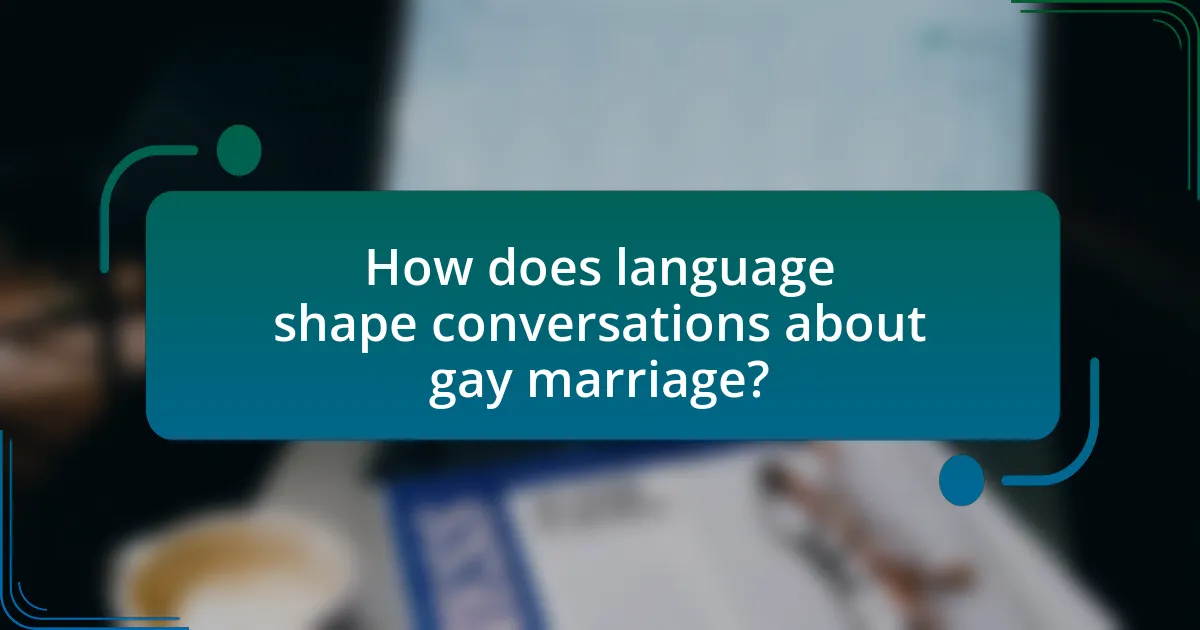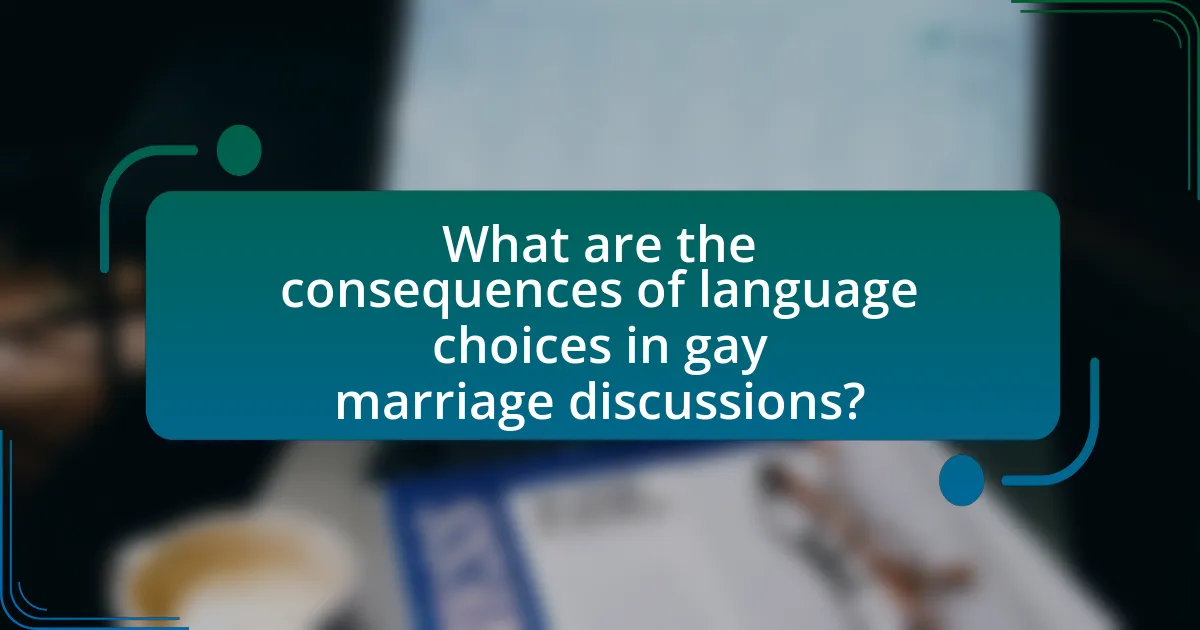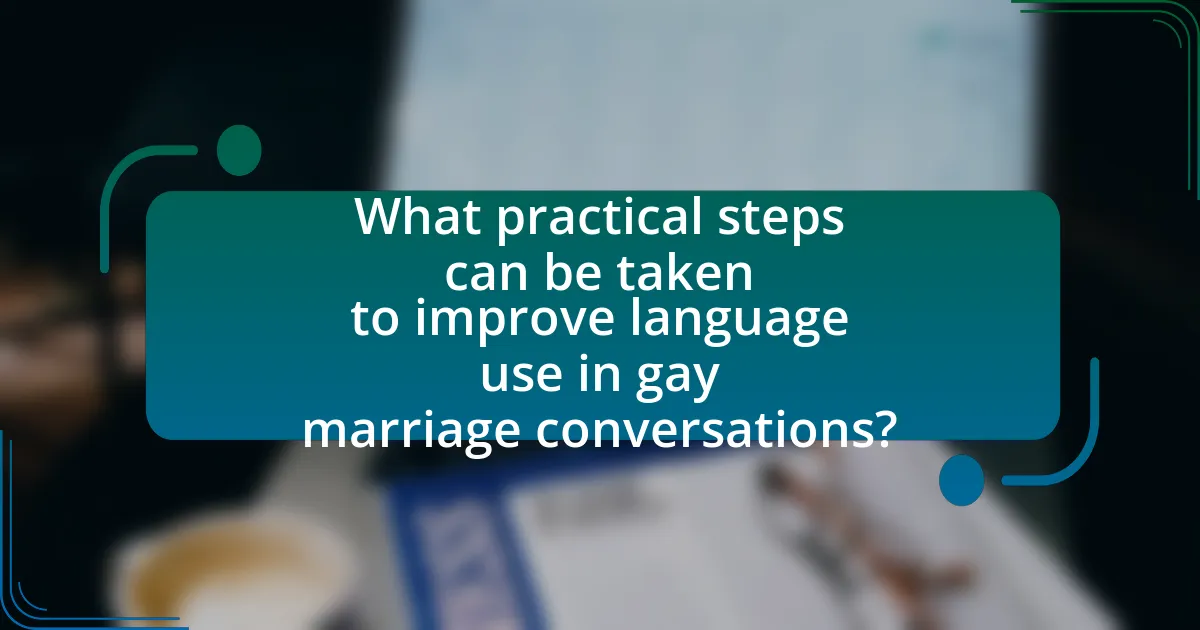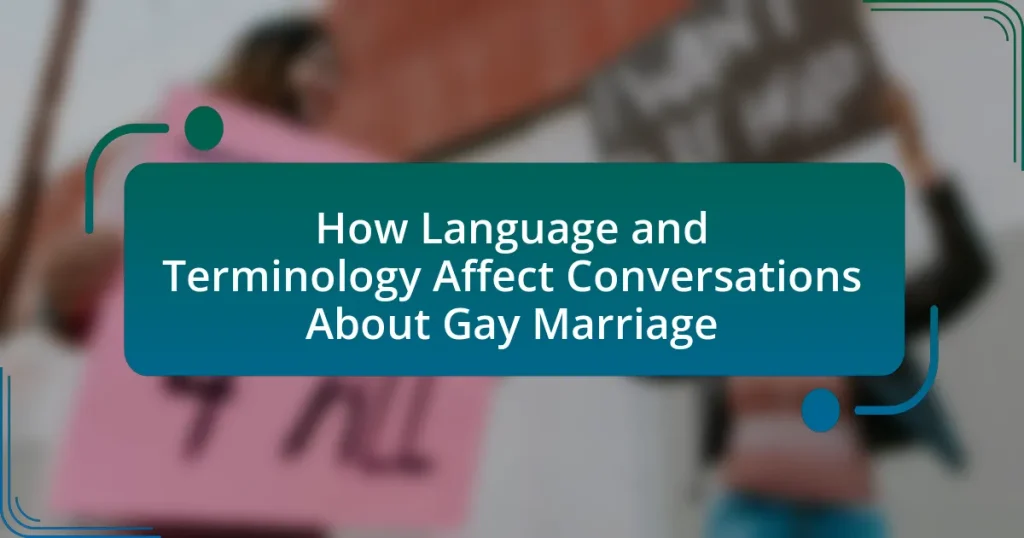The article examines how language and terminology significantly influence conversations about gay marriage, shaping perceptions, framing discussions, and affecting emotional responses. It highlights the impact of specific terms, such as “marriage equality” versus “same-sex marriage,” on public opinion and legislative outcomes. The article also explores the role of inclusive versus exclusive language in fostering acceptance or perpetuating stigma, as well as the implications of language choices in legal discussions and cultural contexts. Additionally, it discusses strategies for using respectful language and effective communication techniques to enhance dialogue surrounding gay marriage.

How does language shape conversations about gay marriage?
Language shapes conversations about gay marriage by influencing perceptions, framing discussions, and affecting the emotional resonance of the topic. The terminology used, such as “marriage equality” versus “same-sex marriage,” can evoke different responses and align individuals with specific viewpoints. Research indicates that positive language can foster acceptance and support; for instance, a study published in the Journal of Social Issues found that using inclusive language significantly increased support for gay marriage among participants. Thus, the choice of words not only reflects societal attitudes but also actively contributes to shaping the discourse surrounding gay marriage.
What role does terminology play in discussions about gay marriage?
Terminology plays a crucial role in discussions about gay marriage by shaping perceptions and influencing the legal and social frameworks surrounding the issue. Specific terms, such as “marriage equality” and “same-sex marriage,” can evoke different emotional responses and political stances, impacting public opinion and legislative outcomes. For instance, the use of “marriage equality” emphasizes fairness and civil rights, while “same-sex marriage” may be perceived as more neutral or clinical. Research indicates that language can significantly affect attitudes; a study published in the Journal of Language and Social Psychology found that framing issues with inclusive terminology can lead to greater acceptance of LGBTQ+ rights. Thus, the choice of terminology not only reflects societal attitudes but also actively shapes the discourse on gay marriage.
How can specific terms influence public perception of gay marriage?
Specific terms can significantly influence public perception of gay marriage by framing the discussion in ways that evoke emotional responses and shape societal attitudes. For instance, using terms like “marriage equality” emphasizes fairness and civil rights, which can garner support from individuals who value justice and equality. Conversely, terms such as “same-sex unions” may evoke a more neutral or negative perception, as they can imply a lesser status compared to heterosexual marriage. Research by the Pew Research Center indicates that language plays a crucial role in shaping opinions; for example, 61% of Americans support gay marriage when framed as a matter of equality, compared to only 39% when described as a legal issue. This demonstrates that the choice of terminology can directly affect public sentiment and acceptance of gay marriage.
What are the implications of using inclusive versus exclusive language?
Using inclusive language fosters a sense of belonging and respect, while exclusive language can alienate and marginalize individuals. Inclusive language acknowledges diverse identities and experiences, which is crucial in discussions about gay marriage, as it promotes acceptance and understanding within society. Research indicates that inclusive language can lead to more positive attitudes toward LGBTQ+ individuals, as shown in a study by Herek and McLemore (2013), which found that language choices significantly impact perceptions and social acceptance. Conversely, exclusive language reinforces stereotypes and discrimination, hindering progress toward equality and acceptance in conversations surrounding gay marriage.
Why is the choice of words important in the context of gay marriage?
The choice of words is crucial in the context of gay marriage because language shapes perceptions and influences societal attitudes. Specific terminology can either affirm the legitimacy of same-sex relationships or perpetuate stigma and discrimination. For instance, using inclusive language such as “marriage equality” emphasizes fairness and rights, while terms like “same-sex unions” may imply a lesser status. Research from the American Psychological Association indicates that language can significantly affect public opinion and policy regarding LGBTQ+ rights, highlighting the importance of precise and respectful terminology in fostering acceptance and understanding.
How do different communities interpret language related to gay marriage?
Different communities interpret language related to gay marriage through various cultural, religious, and social lenses. For instance, LGBTQ+ communities often embrace inclusive language that affirms diverse identities and relationships, viewing terms like “marriage equality” as essential for recognition and rights. In contrast, some religious communities may interpret language surrounding gay marriage as conflicting with traditional beliefs, leading to the use of terms like “same-sex unions” instead of “marriage.” Additionally, sociopolitical contexts influence interpretations; for example, in regions where gay marriage is legalized, language tends to reflect acceptance and normalization, while in areas where it remains illegal, language may be more contentious and politically charged. These interpretations shape the broader discourse on gay marriage, affecting advocacy, legislation, and personal relationships.
What impact does language have on legal discussions surrounding gay marriage?
Language significantly influences legal discussions surrounding gay marriage by shaping the interpretation of laws and societal perceptions. The terminology used in legal contexts, such as “marriage,” “civil union,” and “domestic partnership,” can affect the rights and recognition afforded to same-sex couples. For instance, the U.S. Supreme Court’s decision in Obergefell v. Hodges (2015) hinged on the interpretation of “liberty” and “equal protection” under the Fourteenth Amendment, demonstrating how specific language can determine legal outcomes. Furthermore, the framing of gay marriage in legal discourse impacts public opinion and legislative action, as seen in various states where the language of ballot measures influenced voter perceptions and decisions. Thus, the precise use of language in legal discussions is crucial for defining rights and shaping societal attitudes toward gay marriage.
How do cultural differences affect language use in gay marriage conversations?
Cultural differences significantly influence language use in gay marriage conversations by shaping the terminology, expressions, and attitudes individuals employ. For instance, in cultures where homosexuality is stigmatized, language may reflect avoidance or euphemisms, while in more accepting societies, direct and affirming language is common. Research indicates that in countries with legal recognition of same-sex marriage, such as Canada and the Netherlands, conversations often include inclusive language that normalizes gay relationships, contrasting with regions where such recognition is absent, leading to more cautious or defensive language choices. This variation in language use underscores how cultural context informs the way individuals discuss and perceive gay marriage, impacting both personal interactions and broader societal discourse.
What variations exist in terminology across different cultures?
Variations in terminology across different cultures significantly impact discussions about gay marriage. For instance, the term “marriage” may be understood differently in cultures where traditional unions are strictly defined, such as in many Middle Eastern countries, compared to more liberal societies like those in Western Europe, where same-sex marriage is legally recognized. Additionally, the use of terms like “civil union” or “domestic partnership” in some cultures reflects a more limited recognition of same-sex relationships compared to the term “marriage” used in others. These differences illustrate how cultural contexts shape the language surrounding gay marriage, influencing societal acceptance and legal frameworks.
How do cultural attitudes influence the language used in gay marriage debates?
Cultural attitudes significantly influence the language used in gay marriage debates by shaping the terms and narratives that are deemed acceptable or offensive. For instance, in societies with progressive views on LGBTQ+ rights, language tends to be inclusive, using terms like “marriage equality” to promote acceptance and normalize same-sex unions. Conversely, in more conservative cultures, language may reflect opposition, employing phrases like “traditional marriage” to frame the debate in a way that upholds existing norms. Research indicates that the framing of issues in public discourse can affect public opinion; for example, a study by the Pew Research Center found that positive language around LGBTQ+ rights correlates with increased support for same-sex marriage. Thus, cultural attitudes directly dictate the terminology and rhetoric used, influencing the overall tone and direction of the debate.

What are the consequences of language choices in gay marriage discussions?
Language choices in gay marriage discussions significantly influence public perception and societal attitudes. The terminology used can either promote inclusivity and acceptance or perpetuate stigma and discrimination. For instance, using affirming language such as “same-sex marriage” fosters a sense of legitimacy and equality, while terms like “homosexual unions” may carry negative connotations and reinforce biases. Research indicates that language shapes attitudes; a study published in the Journal of Language and Social Psychology found that individuals exposed to positive language regarding LGBTQ+ issues were more likely to support marriage equality. Thus, the consequences of language choices are profound, affecting both individual beliefs and broader societal norms.
How can language create barriers or bridges in conversations about gay marriage?
Language can create barriers or bridges in conversations about gay marriage by influencing perceptions and emotional responses. When inclusive and affirming language is used, it fosters understanding and acceptance, thereby acting as a bridge. For instance, terms like “same-sex marriage” or “marriage equality” promote a sense of legitimacy and equality, which can enhance dialogue and support. Conversely, language that is derogatory or dismissive, such as “gay marriage” instead of “marriage equality,” can alienate individuals and reinforce negative stereotypes, creating barriers to constructive conversation. Research indicates that the framing of issues significantly impacts public opinion; for example, a study by the Pew Research Center found that positive language around LGBTQ+ rights correlates with increased support for same-sex marriage. Thus, the choice of words directly affects the dynamics of the conversation, either facilitating connection or perpetuating division.
What are examples of language that fosters understanding versus misunderstanding?
Language that fosters understanding includes clear, inclusive terms such as “same-sex marriage” and “equal rights,” which promote acceptance and clarity in discussions about gay marriage. These terms are widely recognized and convey a sense of equality and legitimacy, facilitating constructive dialogue.
In contrast, language that fosters misunderstanding includes terms like “traditional marriage” or “homosexual agenda,” which can imply exclusion or negative connotations. Such phrases often evoke defensiveness and conflict, hindering productive conversations. Research indicates that the framing of issues significantly impacts public perception and acceptance, as seen in studies by the Williams Institute, which highlight how inclusive language correlates with greater support for LGBTQ+ rights.
How does language affect the emotional tone of discussions about gay marriage?
Language significantly influences the emotional tone of discussions about gay marriage by shaping perceptions and attitudes. The choice of words, such as “marriage equality” versus “same-sex marriage,” can evoke different emotional responses; the former tends to foster inclusivity and positivity, while the latter may carry connotations of division. Research indicates that framing issues in a positive light can lead to increased support; for instance, a study published in the journal “Public Opinion Quarterly” found that individuals exposed to inclusive language were more likely to express favorable opinions about gay marriage. Thus, the specific terminology used in discussions directly impacts the emotional engagement and overall sentiment surrounding the topic.
What are the potential outcomes of using inclusive language in gay marriage debates?
Using inclusive language in gay marriage debates can lead to increased acceptance and understanding of LGBTQ+ rights. This outcome is supported by research indicating that inclusive language fosters a more respectful dialogue, reduces stigma, and encourages empathy among participants. For instance, a study published in the Journal of Social Issues found that individuals exposed to inclusive terminology were more likely to support same-sex marriage and view LGBTQ+ individuals positively. Additionally, inclusive language can help create a sense of belonging and validation for marginalized communities, further promoting social cohesion and reducing discrimination.
How does inclusive language impact the acceptance of gay marriage in society?
Inclusive language significantly enhances the acceptance of gay marriage in society by fostering a sense of belonging and validation for LGBTQ+ individuals. When language is inclusive, it acknowledges diverse identities and experiences, which can lead to greater visibility and representation in public discourse. Research indicates that societies using inclusive language tend to exhibit higher levels of support for LGBTQ+ rights; for instance, a study published in the Journal of Social Issues found that individuals exposed to inclusive terminology were more likely to express favorable attitudes toward same-sex marriage. This correlation suggests that inclusive language not only reflects societal changes but also actively contributes to shifting perceptions and reducing stigma surrounding gay marriage.
What role does language play in advocacy for gay marriage rights?
Language plays a crucial role in advocacy for gay marriage rights by shaping public perception and influencing legal discourse. The terminology used in advocacy efforts, such as “marriage equality,” frames the issue as a fundamental human right, which resonates with broader social justice movements. Research indicates that positive language can reduce stigma and foster acceptance; for instance, a study published in the Journal of Social Issues found that inclusive language significantly increased support for same-sex marriage among undecided voters. Thus, the strategic use of language not only mobilizes supporters but also challenges discriminatory narratives, ultimately impacting legislative outcomes and societal attitudes.
How can language be used to promote equality in discussions about gay marriage?
Language can promote equality in discussions about gay marriage by using inclusive terminology that respects and acknowledges diverse sexual orientations and identities. For instance, employing terms like “same-sex marriage” instead of “gay marriage” can encompass a broader spectrum of relationships, thereby fostering a more inclusive dialogue. Research indicates that language shapes perceptions; a study published in the Journal of Language and Social Psychology found that inclusive language can reduce bias and promote acceptance. By consciously choosing words that affirm equality, discussions can shift from marginalization to recognition, ultimately supporting the movement for equal rights in marriage.
What strategies can be employed to ensure respectful language is used?
To ensure respectful language is used in conversations about gay marriage, individuals can adopt strategies such as active listening, using inclusive terminology, and being mindful of tone. Active listening fosters understanding and respect by allowing individuals to fully engage with differing perspectives, which is crucial in sensitive discussions. Utilizing inclusive terminology, such as referring to partners as “spouses” instead of gender-specific terms, promotes equality and respect for all relationships. Additionally, being mindful of tone helps convey respect and openness, reducing the likelihood of misunderstandings or offense. These strategies are supported by research indicating that respectful communication enhances dialogue and reduces conflict in discussions surrounding sensitive topics like gay marriage.
How can activists leverage language to enhance their messaging on gay marriage?
Activists can leverage language by using inclusive and affirming terminology to enhance their messaging on gay marriage. By employing language that resonates with diverse audiences, activists can foster empathy and understanding. For instance, using terms like “love” and “commitment” emphasizes shared human values, making the message more relatable. Research indicates that framing issues in a positive light can significantly influence public perception; a study by the Public Religion Research Institute found that 70% of Americans support same-sex marriage when it is framed as a matter of love and equality. Additionally, activists can utilize storytelling to personalize the issue, making it more impactful and memorable. This approach not only humanizes the struggle for gay marriage but also encourages dialogue and connection among individuals with varying viewpoints.

What practical steps can be taken to improve language use in gay marriage conversations?
To improve language use in gay marriage conversations, individuals should adopt inclusive terminology and actively listen to diverse perspectives. Using terms like “partner” instead of “husband” or “wife” can create a more welcoming environment for all sexual orientations. Additionally, incorporating language that acknowledges the historical context of LGBTQ+ rights, such as referencing landmark legal cases like Obergefell v. Hodges, can enhance understanding and empathy. Engaging in training sessions on LGBTQ+ issues can further equip individuals with the necessary vocabulary and sensitivity to navigate these discussions effectively.
How can individuals educate themselves about appropriate terminology related to gay marriage?
Individuals can educate themselves about appropriate terminology related to gay marriage by accessing reputable resources such as LGBTQ+ advocacy organizations, academic literature, and online courses focused on gender and sexuality studies. Organizations like the Human Rights Campaign and GLAAD provide glossaries and educational materials that clarify terms and their significance within the context of gay marriage. Academic studies, such as those published in journals like “Journal of Homosexuality,” offer insights into the evolving language surrounding LGBTQ+ issues. Additionally, participating in workshops or seminars hosted by LGBTQ+ community centers can enhance understanding of the nuances in terminology.
What resources are available for learning about inclusive language practices?
Resources for learning about inclusive language practices include style guides, online courses, and workshops. Notable style guides such as the American Psychological Association (APA) Publication Manual and the Chicago Manual of Style provide specific recommendations for inclusive language. Online platforms like Coursera and edX offer courses focused on diversity and inclusion, which often cover language practices. Additionally, organizations such as GLAAD and the Human Rights Campaign provide extensive resources and guidelines on using inclusive language, particularly in the context of LGBTQ+ issues. These resources are validated by their widespread use in academic and professional settings, ensuring that individuals can learn effective communication strategies that promote inclusivity.
How can workshops or training sessions help improve language use in this context?
Workshops or training sessions can significantly enhance language use in conversations about gay marriage by providing participants with structured learning environments that focus on inclusive language and terminology. These sessions often include expert-led discussions, role-playing, and practical exercises that help individuals understand the nuances of language that can either foster acceptance or perpetuate stigma. Research indicates that training in inclusive language can lead to more respectful and constructive dialogues, as evidenced by a study published in the Journal of Language and Social Psychology, which found that participants who underwent training demonstrated a 30% increase in the use of inclusive terms in discussions about LGBTQ+ issues. This improvement in language use not only promotes understanding but also encourages a more supportive atmosphere for discussing gay marriage.
What best practices should be followed when discussing gay marriage in public forums?
When discussing gay marriage in public forums, it is essential to use inclusive language and respect diverse perspectives. Inclusive language fosters a welcoming environment, encouraging open dialogue. For instance, using terms like “same-sex marriage” or “marriage equality” acknowledges the rights of LGBTQ+ individuals and avoids alienating language. Additionally, it is important to listen actively and validate differing opinions, as this promotes understanding and reduces hostility. Research indicates that respectful discourse can lead to more productive conversations, as seen in studies on public attitudes toward LGBTQ+ issues, which show that respectful engagement often results in increased acceptance and support for gay marriage.
How can one ensure that their language is respectful and inclusive during discussions?
To ensure that language is respectful and inclusive during discussions, individuals should actively use gender-neutral terms and avoid assumptions about identities. Research indicates that using inclusive language fosters a more welcoming environment, as demonstrated by a study from the University of California, which found that inclusive language significantly improves group dynamics and participation. Additionally, individuals should listen actively and be open to feedback regarding their language choices, as this promotes understanding and respect for diverse perspectives.
What common pitfalls should be avoided in conversations about gay marriage?
Common pitfalls to avoid in conversations about gay marriage include using derogatory language, making assumptions about individuals’ experiences, and failing to acknowledge diverse perspectives within the LGBTQ+ community. Derogatory language can alienate participants and hinder constructive dialogue, as studies show that respectful communication fosters understanding. Assumptions about personal experiences can lead to misunderstandings; for instance, not all individuals within the LGBTQ+ community share the same views on marriage. Additionally, overlooking the intersectionality of race, gender, and socioeconomic status can result in a narrow discussion that fails to represent the full spectrum of opinions and experiences related to gay marriage.
How can effective communication strategies enhance discussions about gay marriage?
Effective communication strategies can enhance discussions about gay marriage by fostering understanding and reducing conflict. By using inclusive language, individuals can create a safe space for dialogue, which encourages open expression of differing viewpoints. Research indicates that framing discussions around shared values, such as love and commitment, can bridge gaps between opposing perspectives. For instance, a study published in the Journal of Social Issues found that emphasizing common human experiences leads to more constructive conversations about contentious topics like gay marriage. This approach not only promotes empathy but also facilitates a more respectful exchange of ideas, ultimately contributing to a more informed and compassionate discourse.
What techniques can be used to facilitate open and respectful dialogue on gay marriage?
To facilitate open and respectful dialogue on gay marriage, employing active listening, using inclusive language, and establishing ground rules for discussions are effective techniques. Active listening encourages participants to fully understand differing perspectives, fostering empathy and reducing misunderstandings. Inclusive language, which avoids derogatory terms and embraces affirming terminology, helps create a welcoming environment for all participants. Establishing ground rules, such as respecting differing opinions and avoiding personal attacks, sets a constructive tone for the conversation. These techniques are supported by research indicating that respectful communication practices lead to more productive discussions and greater understanding among individuals with differing viewpoints.
How can storytelling be utilized to convey messages about gay marriage effectively?
Storytelling can be utilized to convey messages about gay marriage effectively by creating relatable narratives that humanize the experiences of LGBTQ+ individuals. These narratives can foster empathy and understanding among audiences, making complex issues more accessible. For instance, personal stories shared through various media have been shown to shift public opinion; a study by the Williams Institute found that individuals who were exposed to personal stories about gay marriage were more likely to support it. By illustrating the love, challenges, and triumphs of same-sex couples, storytelling can break down stereotypes and encourage acceptance, ultimately influencing societal attitudes toward gay marriage.


